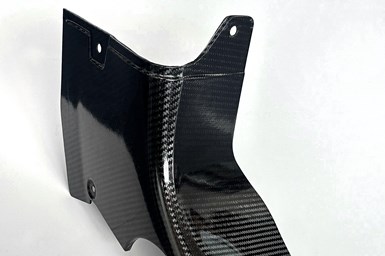Syensqo expands bio-based portfolio with novel MTM epoxy prepreg
Bio-based MTM 49-3 responds to sustainability goals in automotive, containing 30% bio-sourced monomers.
Share
Syensqo (Brussels, Belgium), previously part of Solvay Group, has developed a new version of its flagship MTM 49-3 resin that contains 30% bio-sourced monomers. The product variant complements the portfolio of the company’s MTM prepregs and targets structural automotive applications, including body panels, chassis components and spoilers.
“Our bio-based MTM 49-3 will help OEMs and Tiers to reduce fossil depletion and meet their carbon neutrality goals, while ensuring the same high levels of quality, processability and mechanical performance as its original counterpart,” states Greg Kelly, head of composite product management at Syensqo.
Just like the incumbent material, Syensqo’s novel bio-based MTM 49-3 has a dry glass transition temperature (Tg) of 190°C, and it exhibits enhanced toughness for high impact resistance versus competitive thermoset prepregs. Thanks to its high strength-to-weight ratio, it is reported to yield component mass savings of up to 40% over metals. The product is compatible with autoclave and press-conversion processes and achieves curing at 135°C within 60 minutes. In addition, it has been designed for operator safety, and is free from carcinogens, mutagens or reproductive toxins.
Related Content
-
Combining multifunctional thermoplastic composites, additive manufacturing for next-gen airframe structures
The DOMMINIO project combines AFP with 3D printed gyroid cores, embedded SHM sensors and smart materials for induction-driven disassembly of parts at end of life.
-
TU Munich develops cuboidal conformable tanks using carbon fiber composites for increased hydrogen storage
Flat tank enabling standard platform for BEV and FCEV uses thermoplastic and thermoset composites, overwrapped skeleton design in pursuit of 25% more H2 storage.
-
The potential for thermoplastic composite nacelles
Collins Aerospace draws on global team, decades of experience to demonstrate large, curved AFP and welded structures for the next generation of aircraft.

